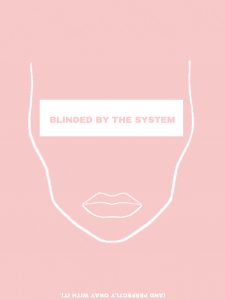TITLE OF WORK: THE HAVES & THE HAVE NOTS
BRIDGE PROJECT SUMMARY: Students were asked to create a zine that addresses a specific social or political issue in the science fiction world of a given film or television show. The creator of said zine should act as an inhabitant of this fictional world, advocating for a position on the chosen social or political issue. The zine, which should be at least six pages in length (in addition to a front and back cover), is intended to function as agitational propaganda. When creating the zines, students should consider the construction of the zine, the size and texture of the paper, and colors used, and how all these elements may contribute to the message or idea expounded within the zine.
“MATERIALS” USED:
(For creation of visuals):
Digital technology/Photoshop/Indesign
(For construction of zine):
Standard 8.5 x 11″ paper
PROJECT REFLECTION:
For my zine project, I chose to watch an episode of the British television show “Black Mirror”. I picked the debut episode of the third season, an episode called “Nosedive”. The episode is set in a world where people can essentially “rate” each other using a zero-to-five star digital ranking system. The aforementioned ranking system is so pervasive in this society, that those who conform or submit to the system govern themselves according to the system. In other words, every action, interaction, and relationship is influenced by the prospect of receiving a good or bad rating. Individuals with high rankings (4.5 or above) tend to receive more benefits; not only are they well-liked and “popular”, but they can also acquire discounts on luxury apartments and fly first-class. Likewise, those with low-rankings are without privileges; they are banned from certain public services and are generally ignored or mistreated by other members of society who fear their own rankings will be affected by interacting with low-ranking individuals.
Nosedive functions as a heightened reflection of our own reality; the episode addresses society’s collective tendency to allow social media to dictate our lives, the relationships we have with others, and the way in which we govern ourselves. While we may not have a system or program that allows us to rank other members of society (it is worth noting, however, that an app with this exact purpose was introduced not too long ago, although it was met with severe criticism), we are a society that is driven by our technology. The way we present ourselves on social media is not unlike the way the characters in Nosedive operate in real-life settings; everything is carefully curated and maintained to project a certain image. Social media allows us to dictate what parts of ourselves we wish to reveal and which parts we wish to keep to ourselves. People are driven by a desire to receive validation and positive affirmations from other social media users. Self worth is often based off of how many likes a picture or post receives, or the number of followers a person has. It’s even true that those with high follower counts receive privileges that those with low follower counts do not; one can get paid for his or her posts on Instagram if she has a significant number of followers. While we may not carry our numbers with us or allow these numbers to dictate our lives to the extent that the people in “Nosedive” have, it is still most certainly a cause for concern. Are we relying too heavily on social media and follower counts to define our self worth? Are the most powerful people not the ones who have a significant following, but the ones who have effectively rejected this self-imposed system?
For my zine, I chose to mimic the pastel color palette seen in the aforementioned episode of Black Mirror. Normally, pastel hues evoke a sense of calmness or serenity, but when juxtaposed with the absurdity of the ranking system, the colors are, to some degree, unsettling. I took the position of a member of society who seeks to reject the ranking system; this person advocates for rebellion by way of embracing a low ranking. I chose to employ text as a design element, keeping the composition of each page generally simple to highlight and emphasize the content of the text. Several of the pages use crude language as an homage to the final scene of Nosedive, wherein the main character, Lacie, is thrown into a jailhouse and stripped of her system after a violent outburst at her childhood best friend’s wedding. She encounters another incarcerated individual, the two begin to swear at each other — a testament to the fact that the two are now free from the oppressive ranking system.








